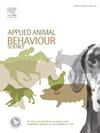Prediction of assistance dog training outcomes using machine learning and deep learning models
IF 2.2
2区 农林科学
Q1 AGRICULTURE, DAIRY & ANIMAL SCIENCE
引用次数: 0
Abstract
This study investigates the predictive power of machine learning and deep learning models for forecasting training outcomes in assistance dogs, using behavioral survey data (C-BARQ) collected from volunteer puppy-raisers at two developmental stages: 6 months and 12 months. We used data from two assistance dog training organizations–Canine Companions and The Seeing Eye, Inc.– to assess model performance and generalizability across different training contexts. Six models, including traditional machine learning approaches (SVM, Random Forest, Decision Tree, and XGBoost) and deep learning architectures (MLP and CNN), were trained and evaluated on C-BARQ behavioral scores using metrics such as accuracy, F1 Score, precision, and recall. Results indicate that Support Vector Machine (SVM) and XGBoost consistently delivered the highest prediction accuracy, with SVM achieving up to 80 % accuracy in the Canine Companions dataset and 71 % in the Seeing Eye dataset. Although deep learning models like CNN showed moderate accuracy, traditional machine learning models excelled, particularly in structured, tabular data where feature separability is essential. Models trained on 12-month data generally yielded higher predictive accuracy than those trained on 6-month data, highlighting the value of extended behavioral observations. This research underscores the efficacy of traditional machine learning models for early-phase prediction and emphasizes the importance of aligning model selection with dataset characteristics and the stage of behavioral assessment.
使用机器学习和深度学习模型预测辅助犬训练结果
本研究调查了机器学习和深度学习模型在预测辅助犬训练结果方面的预测能力,使用了从6个月和12个月两个发育阶段的志愿养狗者收集的行为调查数据(C-BARQ)。我们使用了两个辅助犬训练组织——canine Companions和The Seeing Eye, Inc.——的数据来评估模型在不同训练背景下的性能和普遍性。包括传统机器学习方法(SVM、Random Forest、Decision Tree和XGBoost)和深度学习架构(MLP和CNN)在内的6个模型进行了训练,并使用准确性、F1 Score、精度和召回率等指标对C-BARQ行为评分进行了评估。结果表明,支持向量机(SVM)和XGBoost始终提供最高的预测精度,SVM在犬类同伴数据集中实现高达80 %的准确率,在视力数据集中实现71 %的准确率。虽然像CNN这样的深度学习模型显示出适度的准确性,但传统的机器学习模型表现出色,特别是在结构化的表格数据中,特征可分离性是必不可少的。使用12个月数据训练的模型通常比使用6个月数据训练的模型具有更高的预测准确性,这突出了扩展行为观察的价值。本研究强调了传统机器学习模型在早期阶段预测中的有效性,并强调了将模型选择与数据集特征和行为评估阶段相一致的重要性。
本文章由计算机程序翻译,如有差异,请以英文原文为准。
求助全文
约1分钟内获得全文
求助全文
来源期刊

Applied Animal Behaviour Science
农林科学-行为科学
CiteScore
4.40
自引率
21.70%
发文量
191
审稿时长
18.1 weeks
期刊介绍:
This journal publishes relevant information on the behaviour of domesticated and utilized animals.
Topics covered include:
-Behaviour of farm, zoo and laboratory animals in relation to animal management and welfare
-Behaviour of companion animals in relation to behavioural problems, for example, in relation to the training of dogs for different purposes, in relation to behavioural problems
-Studies of the behaviour of wild animals when these studies are relevant from an applied perspective, for example in relation to wildlife management, pest management or nature conservation
-Methodological studies within relevant fields
The principal subjects are farm, companion and laboratory animals, including, of course, poultry. The journal also deals with the following animal subjects:
-Those involved in any farming system, e.g. deer, rabbits and fur-bearing animals
-Those in ANY form of confinement, e.g. zoos, safari parks and other forms of display
-Feral animals, and any animal species which impinge on farming operations, e.g. as causes of loss or damage
-Species used for hunting, recreation etc. may also be considered as acceptable subjects in some instances
-Laboratory animals, if the material relates to their behavioural requirements
 求助内容:
求助内容: 应助结果提醒方式:
应助结果提醒方式:


